History of the Carthusian monastery
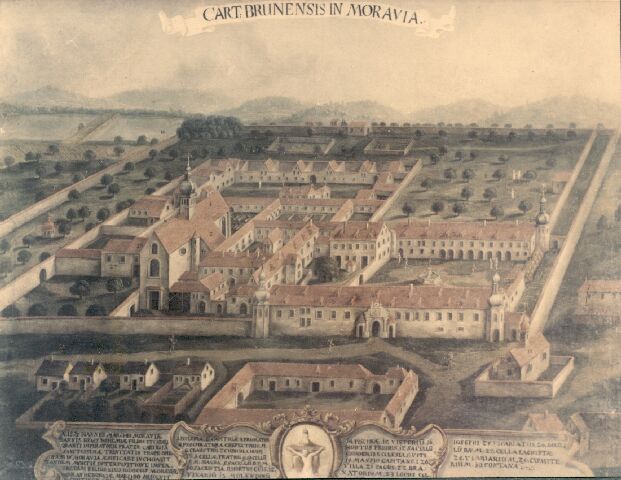
Carthusian monastery in Kralovo Pole
The former Carthusian monastery in Kralovo Pole (Königsfeld, King's Field) is the first and in its structural composition, the unique Carthusian monastery preserved in Moravia. After having chosen Brno as his seat from November 26 1349, the Margrave Jindrich, Emperor Charles's IV younger brother, bought a large estate in the vicinity of the village Kralovo Pole. All his property was given to the new monastery "Cella Trinitatis" - Church of the Holy Trinity, as is stated in the foundation document dated August 13 1375, and this monastery was settled by the Carthusian monks who came to this place from Gaming in Upper Austria.
The erection of the Church of Holy Trinity was commenced
immediately after foundation, and the co-founder Margrave Prokop,
Margrave Jost's (Jodocus) younger brother was buried in the
vaulted crypt that was situated in the middle of the fathers
choir. The church had created also the axis of a large arcade
courtyard before it was enlarged southwards, in the second half
of the 17th century. The unified space of the Holy Trinity Church
belongs to a small group of one nave churches which has the
significant features of Carthusian architecture, and it connects
the two chapels on both sides in straight direction and the
former vestry (Angel Chapel) as well as the former capitular hall
(Chapel of Maria Annunciation). The rood loft was subordinated to
the basic unit of the space and divided the interior of fathers
choir and the part of brethren choir. The interior unstructured
wall was rehabilitated because of making use of it as
a supporting surface for the choir pews put in lines along this
wall. All three space units preserved their polygonal choir
shutting dating from the time of their foundation, as well as
their flat vault ending in several groins.
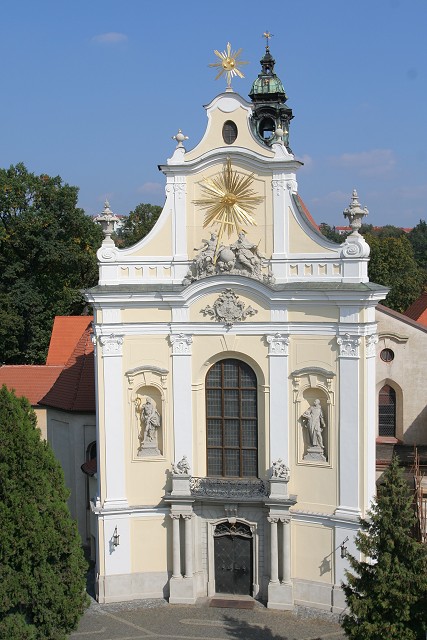
Being reconstructed in baroque style the Church of Holy Trinity lost its gothic vertical lines. The originally narrow front was rebuilt in a very rich baroque scene in the 60th of the 18th century, and was completed by very precious statues from the sculptor O. Schweigel. The baroque unit the Swedish Chapel is very significant in its oval shape, but outside it has polygonal ground-plan, the mirage of St. Maria from the 16th century is very precious. This painting was damaged by 48 shoots at the time of Swedish siege of Brno in 1645. The renaissance rich structured pews in arcade style in the brethren's choir, and they are the same as the pews in the Jesuitical Church and were cut by a monk Emerich Thurn from Rastadt in Baden at the beginning of the 17th century.
Ondrej Schweigel endowed the main altar with the statues of
St. Bruno and St. John the Baptist, which were made in 1763, he
also made a group of statues St. Maria Annunciation for the
capitular hall and the statues for the Angel Chapel. It was
a pity that the painting on the main altar made by the painter
Tobias Pock from Vienna, was substituted by a less valuable
picture by Josef Zelenyin the 80th of the 19th century. The
interior of the church was during the baroque reconstruction
completed by a new rood-loft between both choirs and by
a considerable charged cornice. The gothic pads of the vault
consoles were lengthened to the cornice and got feet on a socle
pedestal. Through this reconstruction there were made twelve
fields that were decorated by the painter Josef Stern from Brno,
who placed there very excellent set of pictures of Twelve
Apostels. The gothic entrance to the old vestry and the former
capitular hall were rebuilt into baroque ones. The two alters
covering the front of the baroque rood-loft in both sides of the
axis prospects originally closed by a lattice, were replaced after
the conclusion of the monastery of Kralovo Pole in January 18
1782. Both altars with the pictures by Josef Leichner - the
co-operator of F.A.Maulbertsch, were put on the place of brethren
pews in the front space of the church after the demolition of the
baroque rood-loft. The Swedish chapel got significant rococo
features through the ceiling painting of Apotheosis of St.
Trinity by the excellent picture from Maulbertsch, as well as
through a marble architecture of the altar in the middle of which
is the miraculous image of St. Maria and also through the
masterly forget lattice.
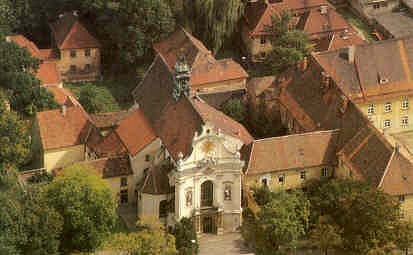
The pads of the vault groins were transferred in vertical tectonic units in the side chapels as well as in the church. The cordon cornice line separates the lower stripe of the building from the decorative fields, which are structured by small pillars cut in the corners. The wall painting was made only above the cordon cornice but it was not made in the church. The theme of the Maulbertsch's painting in the former capitular hall (Chapel of St. Maria Annunciation) is directly bound to the life in the order, to the Carthusian monastery in Kralovo Pole and to the Czech history of the church (Allegory of Church and Faith, St. Bruno and a fragment of St. Jeronym, founder John Henry Margrave of Moravia, his contemporary fellowmen St. Jan of Nepomuk and the Czech queen Sofia). A very rich ornamental and baroque-classical painting on the vault is preserved in the old vestry. The detailed research of the paintings proved that the decorative painting stretching into the fields of the vault and framing the Maulbertsch's scenes are the work of Maulbertsch's fellow-labourer. The scenes in the old vestry are connected by a figure of Angel the Messenger, who plays a significant role in the stories in Old and New Testament. The closing of the contemporary Angel Chapel represent the painting of St. Maria Announciation and the vision of St. Zachrius' in the four side fields are pictures of God's Messenger visiting the judge Gedeon, another of apostle St. John, picture depicting the dream of St. Joseph and of the prophet Elias. Two angel figures by Schweigel are pointing at a dramatically impressing picture of Archangel Michael, made by Martin J. Schmidt. Under the tiles of Angel Chapel were buried the bodily remains of Prokop Luxemburg the co-founder of the Carthusian monastery in Kralovo Pole (1358 - 1405). A marble record was put into the new tiles and it lies almost directly above the same place of the casket with the casket with the bodily remains in the gothic tomb of Margrave, which were found in the adjoining father choir in 1975.
Through the old vestry we come to the north part of the cloister arcade that surrounded the large monastery court of Kralovo Pole. There are still the gothic cells B, C, D, E with the small opening for serving the meals. These cells were found in the basement and were covered with a barrel vaulting during the baroquisation in 1688. The archaeological digging that was made by Museum of Brno in the neighbouring baroque cell A showed the original disposition with a fireplace and a privet and it is the same as that one discovered in Carthusian monastery in Dolany near Olomouc, which was founded in 1389.
The original cells placed in the basement were covered with
wooden beams and they had a steep saddle roof at the first baroque
reconstruction above the cell B when there was added one floor
more. A part of the cloister between the cell A and the old
vestry is preserved in gothic style with the gothic smoothed
plaster.
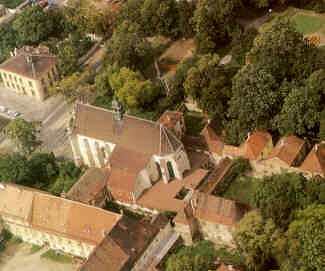
The small monastery court and the church made the border to the parallel brethren wing in the south. The brethren lived on the first floor above refectory and they took care of the monastery maintaining.
From the church it was possible to get into the small
cloister through a connecting passage along the newer entrance
into the capitular hall. The erection of a new connecting wing to
the church and to both branches of small cloister was forced
through the lengthening of the small south cloister built in the
70th of the 18th century. Archaeological research proved that the
original medieval chapel of St. Maria had extended to the
brethren court and at that time had a three-leaf ground-plan as
the symbol of St. Trinity. The original altar paintings of St.
Peter and St. Maria bought 1781 from the painter M. Knoller in
Milan were put again on the wall in the northern wing of the
small cloister that was facing the former brethren court. The
stone baroque escutcheon with the heraldic figure of Carthusian
monastery was used again in the western front, it was the same
coming from the large portal architecture from the destroyed
house belonging to the Carthusian order in Brno.
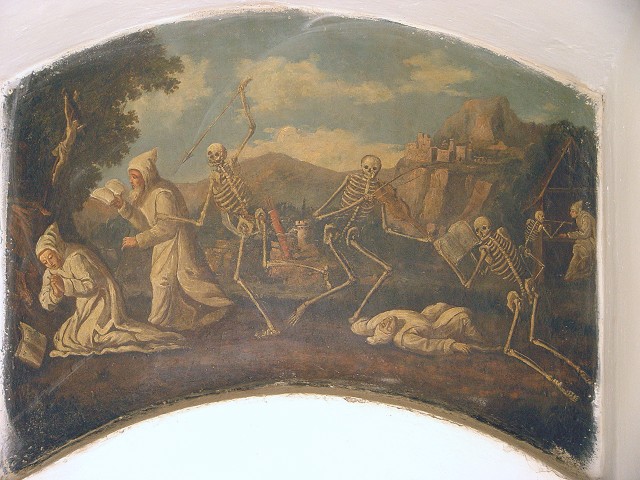
The objects of the medieval part of the monastery in the south-west are an adjoining complex. These were a port of the residence given to the Carthusian monks by Margrave Jan Jindrich and these monks lived in this residence during the erection of the monastery. The oblique line of the entrance that was put between the gothic part of the administrative house and the neighbouring building in trapezium form has no connection with the foundation of the gothic origin of the monastery. The trapezium form of the ground-plan makes a transformation change to the original gothic building of oblong ground-plan that is a part of a baroque entrance into the monastery of Kralovo Pole and it is connected with the work of the builder of early baroque time Jan Krtitel Erna in Brno. A very interesting Carthusian painting "The Dance of Death" is placed on the front vault arch in the staircase to the first floor. The opposite building of the new Priorhouse is a part of the new space conception that connected the new court oblong shape with an older unit in the 2nd half of the 17th century. The storied wing of the refectory extends deeply into the court of the confinement and separates it into two unequal parts. The covering of the oblique shape comes from the beginning of the 18th century and has a rich stucco decoration made by G. A. Corbellini, who made as well the decoration in the Reliquary Chapel. After being heightened with one floor because of the new library hall in the second half of the 18th century the periphery walls of this refectory wing were arranged into strings which are the same as these in the front of the Carthusian monastery' dated 1688.
The second baroque reconstruction of the monastery in
Kralovo Pole began with the significant adaptation of the church in
1765. The later baroque reconstruction was made in the cells of
the east and south line as well as in the group of buildings in
the court of brethren and in the wing of refectory in the 70th of
the 18th century. In the entrance court the originally open
arcades in the new Priorhouse were walled up and most of the
buildings were unified regardless to their different functions.
The temperate baroque-classical adaptation of the court and the
three towers that got the pavilion shutting, closed the
development of the Carthusian monastery in Kralovo Pole as
a specific organism.
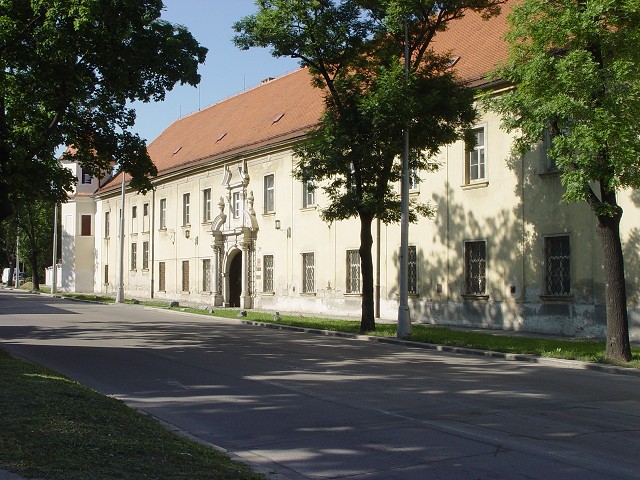
After the monastery was given under the military administration there has begun large maintenance and adaptation work. Large changes of the buildings affected the brethren court and disturbed the intimate of the cloister in 1871 - 1887. The pillar arcade into the entrance wing was walled up, a new building closing the entrance court in the south was built. The Brno University of Technology as a new landlord since 1963 undertook a gradual reconstruction of the monastery buildings. The Roman-Catholic parish in Kralovo Pole undertook large reconstruction work in the big parts that remained its property. This reconstruction was made for the 600 anniversary of the foundation of the Carthusian monastery.
Short resume of monastery history from: Bukovsky, Jan, 1994: Kralovopolsky kartouz, Brno, ISBN 70-7029-086-2